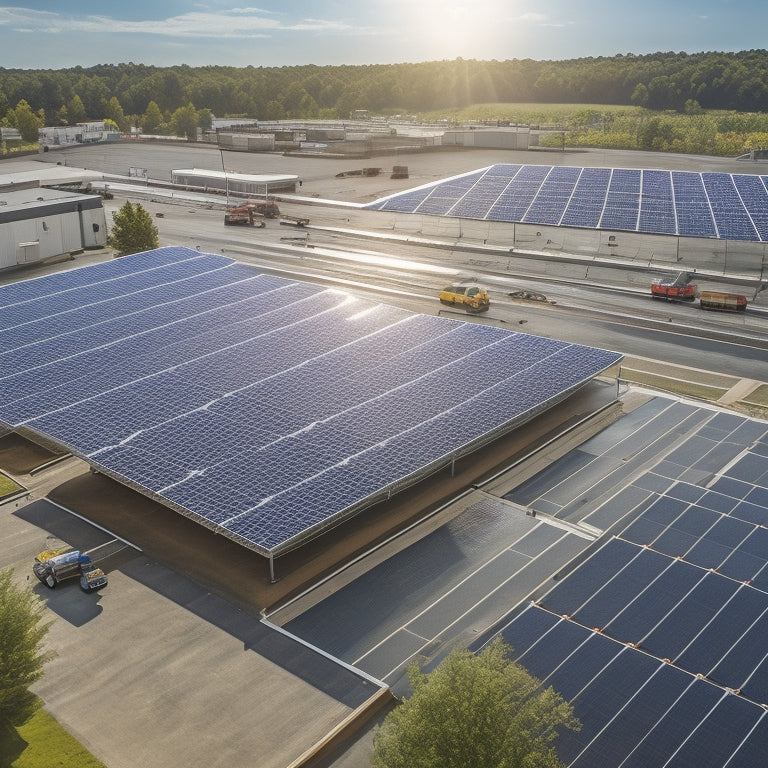
7 Essential Steps for a Business Solar Panel Installation
Share
You'll need to take seven essential steps to successfully install a solar panel system for your business. First, assess your energy needs to determine the right system size. Then, evaluate your roof's suitability, considering its orientation, size, and material. Next, choose a solar panel system that balances efficiency, budget, and warranty options. Obtain necessary permits and approvals, and prepare for installation by guaranteeing environmental compliance and discussing financing options. After installation, connect your system to the grid and test its performance. Finally, monitor and maintain your system to guarantee peak efficiency. Now that you have a solid understanding of the process, you can start making informed decisions to make your shift to solar energy a reality.
Key Takeaways
- Assess energy consumption to identify high-usage areas and evaluate past energy bills for peak usage periods and seasonal fluctuations.
- Ensure the roof is suitable for solar panels by evaluating orientation, size, material, and structural integrity.
- Choose a solar panel system that balances budget considerations with expected return on investment, focusing on panel efficiency and warranty options.
- Obtain necessary permits and approvals, familiarizing yourself with local building codes and zoning ordinances to avoid project shutdowns.
- Consider environmental impacts, such as wildlife habitats and water resources, and ensure compliance with environmental regulations during installation.
Assessing Your Business's Energy Needs
Efficiency is the cornerstone of any successful business, and optimizing your energy usage is an essential aspect of it. In order to determine the feasibility of a solar panel installation, you need to assess your business's energy needs. This involves conducting an energy consumption analysis to identify areas of high energy usage and opportunities for improvement.
You'll want to evaluate your past energy bills, taking note of peak usage periods and seasonal fluctuations.
Next, you'll need to conduct a cost-benefit evaluation to determine the potential savings of a solar panel installation. This will involve calculating the upfront costs of the installation, as well as any ongoing maintenance and repair costs.
You'll also need to take into account the potential benefits, including reduced energy costs, tax incentives, and increased property value.
Evaluating Your Roof's Suitability
You'll need to assess your roof's suitability for solar panels, considering factors that affect energy production and installation feasibility.
Your roof's orientation, size, and shape will influence the system's performance, while its structural integrity is essential for supporting the added weight of the panels.
Roof Orientation Matters
Evaluate your roof's orientation carefully, as it plays an essential role in determining the viability of your business's solar panel installation. The ideal solar panel orientation is south-facing, as it receives the most sunlight exposure throughout the day.
However, if your roof doesn't face south, don't worry – you can still install solar panels. East- and west-facing roofs can also work well, although they'll receive less sunlight exposure.
When analyzing your roof's orientation, consider the time of day when your business uses the most energy. If you use more energy during the morning, an east-facing roof might be suitable. If you use more energy in the afternoon, a west-facing roof could work better.
Keep in mind that any obstructions, such as trees or nearby buildings, can impact the amount of sunlight your solar panels receive. A thorough evaluation of your roof's orientation will help you determine the best solar panel installation for your business.
Roof Size and Shape
Your roof's orientation is just one aspect to evaluate when contemplating its suitability for solar panels.
Another essential consideration is the size and shape of your roof. A larger roof provides more space for solar panels, but it's not the only factor. You'll need to assess the roof's shape and layout to determine the ideal placement of panels.
To guarantee a successful solar panel installation, consider the following key factors:
-
Roof size and layout: A larger roof doesn't always mean more solar panels can be installed. The layout and shape of the roof can impact the number of panels that can be fitted.
-
Roof materials: The type of roofing material you have can affect the installation process and the overall cost. For example, asphalt shingles are easier to work with than metal or tile roofs.
-
Shading analysis: Even partial shading can considerably reduce the energy output of your solar panels. A shading analysis will help identify areas of your roof that receive the most sunlight.
Structural Integrity Check
Inspecting your roof's structural integrity is an essential step in determining its suitability for solar panel installation. You need to verify that your roof can support the weight of the solar panels and withstand various environmental conditions. A thorough inspection will help identify any potential issues that could affect the installation process or the performance of the solar panels.
When evaluating your roof's structural integrity, you should consider the following factors:
| Structural Materials | Load Bearing Capacity |
| Asphalt Shingles | 1-2 pounds per square foot |
| Clay or Concrete Tiles | 3-5 pounds per square foot |
| Metal Roofing | 2-4 pounds per square foot |
| Slate Tiles | 4-6 pounds per square foot |
Your solar panel installation team will assess the condition of your roof, including its age, material, and design. They will also evaluate the roofing structure's ability to support the weight of the solar panels, as well as any additional loads such as wind, snow, or rain. By doing so, they can determine the best way to install the solar panels while verifying the safety and integrity of your roof.
Choosing the Right Solar Panel System
When choosing a solar panel system for your business, you'll need to contemplate system size options that align with your energy needs and roof space.
You'll also want to evaluate panel quality, as higher-efficiency panels can generate more power per hour of sunlight.
System Size Options
A commercial rooftop, once a mere expanse of asphalt shingles, can now be converted into a revenue-generating asset with the right solar panel system.
When choosing the right system, you'll need to take into account the system size options that meet your energy needs and budget.
The ideal system capacity is vital, as it directly affects your energy efficiency and savings.
Here are three key factors to determine the right system size for your business:
-
Energy usage: Assess your business's historical energy consumption to determine the required system capacity. This will guarantee you generate enough electricity to meet your needs.
-
Roof size and space: Evaluate the available rooftop space to determine the maximum system size that can be installed.
-
Budget and ROI: Balance your budget with the expected return on investment (ROI) from the solar panel system. A larger system may provide more savings, but it also increases the upfront cost.
Panel Quality Matters
Your business's shift to solar energy relies heavily on the quality of the solar panel system you choose. A high-quality system will provide you with the maximum return on investment, while a low-quality one can lead to subpar performance and financial losses.
When selecting a solar panel system, you should focus on panel efficiency, which is measured by the amount of electricity generated per unit area. Higher efficiency panels produce more power, taking up less space on your roof. Look for panels with high efficiency ratings, typically above 20%.
Additionally, consider warranty options, which can provide protection against defects, performance degradation, and other issues. A thorough warranty can give you peace of mind and protect your investment.
Be wary of extremely low-cost options, as they often come with lower quality components and limited warranty coverage. By prioritizing panel quality, you can guarantee your business reaps the benefits of solar energy for years to come.
Obtaining Necessary Permits and Approvals
How do you guarantee that your business solar panel installation complies with local regulations and avoids costly delays? Obtaining necessary permits and approvals is an essential step in the installation process.
Failure to do so can result in project shutdowns, fines, and reputational damage.
To facilitate a smooth installation, you'll need to secure approvals from various authorities. Here are three key considerations:
- Local Regulations: Familiarize yourself with local building codes, zoning ordinances, and environmental regulations.
Confirm your installation meets these requirements to avoid costly revisions.
- Utility Requirements: Obtain approval from your utility company to connect your solar panel system to the grid.
This involves meeting their installation guidelines and technical requirements.
- Environmental Assessments: Conduct environmental assessments to identify potential impacts on wildlife habitats, water resources, or other sensitive ecosystems.
This helps you mitigate risks and guarantee compliance with environmental regulations.
Installing the Solar Panel System
Installing the solar panel system marks an essential milestone in your business's shift to renewable energy. With necessary permits and approvals in hand, you're ready to begin the installation process. Your chosen solar panel provider will handle the installation, making certain that the system is installed correctly and meets local building codes.
Before installation begins, review your financing options to make sure you're comfortable with the payment schedule. Discuss any concerns with your provider to make sure a smooth process.
Next, confirm the installation timeline, which typically takes several days to several weeks, depending on the system's size and complexity.
During installation, the solar panel provider will prepare your roof, install the mounting system, and connect the solar panels. They'll also connect the inverter, which converts DC power to AC power for your business's use.
Verify that the installation team is experienced and certified to assure a high-quality installation. A well-executed installation is vital to maximizing your solar panel system's energy output and longevity.
Connecting to the Grid and Testing
The grid connection marks a critical phase of the business solar panel installation, as it enables the system to feed excess energy back into the grid and offset your electricity bills.
This phase requires careful planning and execution to guarantee a safe and efficient connection.
During the grid connection process, you'll need to:
-
Inspect and test the electrical infrastructure: Verify that the electrical infrastructure can support the solar panel system's power output and meet the grid connection requirements.
-
Configure the inverter and monitoring system: Set up the inverter to convert DC power from the solar panels to AC power, and configure the monitoring system to track the system's performance.
-
Perform performance testing: Conduct thorough testing to verify the system is operating at peak levels, meets safety standards, and is ready for grid connection.
Once these steps are complete, your business solar panel installation will be ready to generate clean energy and start saving you money on your electricity bills.
Monitoring and Maintaining Performance
With your business solar panel installation now connected to the grid and generating clean energy, it's essential to monitor and maintain its performance to guarantee ideal energy production and maximize your savings.
You'll want to track key performance metrics, such as energy output, to verify your system is operating at peak efficiency. Regular maintenance schedules will help prevent issues and identify potential problems early on.
This includes inverter maintenance, cleaning techniques, and troubleshooting issues as they arise. By staying on top of performance, you'll be able to take advantage of system upgrades and optimize your energy monitoring.
This proactive approach will lead to long-term savings and a reduced environmental impact.
Don't forget to review your warranty considerations and understand what's covered in case you need repairs or replacements.
Frequently Asked Questions
What Are the Tax Incentives for Commercial Solar Panel Installations?
You'll benefit from federal incentives, like the Solar Investment Tax Credit, which allows you to claim 26% of your installation costs as a credit, plus state rebates, which vary by location, to maximize your commercial solar panel installation's ROI.
Can I Install Solar Panels on a Leased or Rented Property?
You'll need to review your lease agreements to determine if installing solar panels is allowed, and obtain installation permissions from your landlord, as some leases may have restrictions or require additional approvals.
How Do I Ensure Solar Panels Are Secure From Theft or Vandalism?
You're investing in clean energy, but thieves see dollar signs. You'll want to safeguard your solar panels with strong security measures, like tamper-evident fasteners, motion-sensitive lighting, and surveillance cameras, to prevent theft and vandalism, ensuring your eco-friendly investment remains intact.
Can I Use Solar Panels to Power My Business During a Grid Outage?
You can achieve grid independence by investing in a solar battery backup system, allowing your business to remain powered during outages, and enjoying uninterrupted operations while reducing your reliance on the grid.
Are There Any Warranties or Guarantees for Commercial Solar Panels?
You're wise to wonder about warranties, as they greatly impact panel lifespan and installation costs. Typically, commercial solar panels come with 25-year warranties, covering defects and performance guarantees, giving you peace of mind and financial protection.
Conclusion
You've successfully maneuvered the essential steps for a business solar panel installation. Now, you're ready to utilize the power of renewable energy and reap the benefits. For instance, a company like Google, which installed a 1.6-megawatt solar panel system at its Mountain View campus, is expected to save $394,000 in energy costs annually. By following these steps, you too can enjoy significant energy savings and a reduced carbon footprint.
Related Posts
-

Essential Accessories for Heavy Riders of E-Bikes
As a heavy rider of an e-bike, you need specialized gear that caters to your unique needs. Start with safety essentia...
-

Top Online Stores for Solar Car Accessories
When searching online for solar car accessories, you'll find top retailers like Amazon, REI Co-op, and Best Buy offer...
-

Step-by-Step Guide to Converting Your Vehicle to EV
You'll begin by evaluating your vehicle's conversion potential, analyzing its weight, aerodynamics, and powertrain co...


